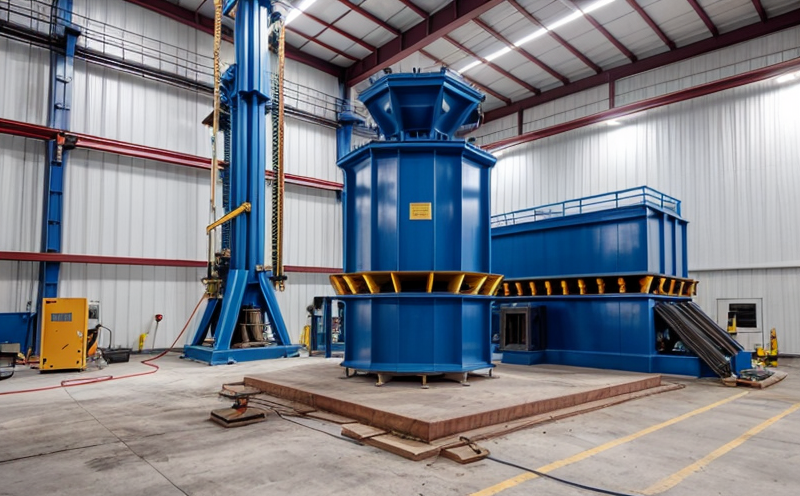ASTM E1781 Vibration Damping Test of Structural Joints
The ASTM E1781 vibration damping test evaluates the damping properties of structural joints subjected to dynamic loading. This critical test is pivotal for ensuring that structural components can dissipate energy effectively under vibratory stress, thereby preventing excessive deformation and potential failure.
Understanding structural joints’ capacity to absorb vibrations is essential in various sectors such as automotive manufacturing, aerospace engineering, civil construction, and mechanical design. In these industries, the integrity of structural joints directly impacts the overall safety and longevity of products or structures. The ASTM E1781 test provides a standardized method for assessing this critical property.
The test involves subjecting specimens to cyclic loading in a controlled environment. Specimens are typically made from various materials like metals, polymers, composites, or hybrid materials used in structural joints. The specimen’s ability to dissipate vibratory energy is quantified by measuring the damping ratio, which indicates how efficiently the material absorbs and converts mechanical energy into heat.
The test setup includes a vibration testing machine with frequency sweep capabilities. This machine applies controlled oscillations over a range of frequencies, simulating real-world environmental conditions. The response of the specimen to these applied vibrations is carefully monitored using sensors such as accelerometers, displacement transducers, and strain gauges. These instruments provide real-time data on how the specimen behaves under dynamic loading.
Post-testing analysis involves evaluating several parameters including peak strain, damping ratio, and hysteresis loop area. The results are compared against specified standards to determine compliance with industry requirements. Compliance ensures that the structural joints meet safety and performance criteria necessary for their intended application.
The ASTM E1781 test is particularly important in industries where the integrity of structural components can affect human life or property, such as automotive crashworthiness, aerospace structures, and offshore wind turbine foundations. By ensuring that structural joints have adequate damping properties, manufacturers can enhance product safety while reducing maintenance costs associated with premature failure due to vibration.
The ASTM E1781 standard is widely recognized for its reliability in assessing the damping performance of materials used in structural joints. It provides a consistent methodology for testing, making it easier for industries to compare results across different suppliers or projects. This ensures that all parties involved have confidence in the quality and durability of their products.
In conclusion, the ASTM E1781 vibration damping test is an essential tool for ensuring the safety and performance of structural joints. By providing a standardized approach to evaluating damping properties under controlled conditions, it helps manufacturers produce reliable components that can withstand the rigors of real-world use.
Industry Applications
| Industry Sector | Common Application |
|---|---|
| Aerospace Engineering | Evaluating damping properties in aircraft structures to enhance safety during turbulence. |
| Civil Construction | Determining the durability of bridge components under varying traffic conditions and environmental stressors. |
| Automotive Manufacturing | Assessing the crashworthiness of vehicle structures to improve passenger safety during accidents. |
| Mechanical Design | Evaluating joint performance in machinery that operates under high-frequency vibrations for enhanced reliability. |
The ASTM E1781 test is particularly crucial in sectors where the structural integrity of components plays a vital role in overall system performance. Its application spans from ensuring the safety of critical infrastructure to improving the quality and longevity of consumer products. By providing consistent results, this test supports industries in meeting regulatory requirements while maintaining high standards of product excellence.
Why Choose This Test
- Promotes safer structural joints by ensuring they dissipate vibratory energy effectively.
- Facilitates compliance with international standards, enhancing marketability and trustworthiness.
- Offers a standardized method for evaluating damping properties across various materials and applications.
- Supports R&D efforts in optimizing joint design to improve performance and reduce failure rates.
- Ensures consistent quality control through repeatable testing procedures.
- Improves product reliability by identifying potential weaknesses early in the development process.
- Aids in regulatory compliance, ensuring products meet safety and performance requirements set forth by governing bodies.
- Enhances reputation among clients and stakeholders by demonstrating a commitment to high-quality manufacturing practices.
The ASTM E1781 vibration damping test is an indispensable tool for industries seeking to enhance the reliability and safety of their structural joints. By choosing this rigorous testing method, manufacturers can ensure that their products not only meet but exceed industry standards, ultimately leading to higher customer satisfaction and greater market success.
International Acceptance and Recognition
The ASTM E1781 vibration damping test enjoys widespread international acceptance and recognition due to its robust methodology and consistent results. It is widely adopted by regulatory bodies, certification organizations, and industry associations around the world. This standard is recognized for its reliability in assessing the damping properties of structural joints, making it a preferred choice for quality assurance and compliance.
Regulatory bodies such as the Federal Aviation Administration (FAA) and European Union Aviation Safety Agency (EASA) often require compliance with ASTM E1781 standards. Similarly, certification organizations like Underwriters Laboratories (UL) and International Organization for Standardization (ISO) frequently reference this test in their guidelines and requirements.
Industry associations such as the Society of Automotive Engineers (SAE) and American Society of Civil Engineers (ASCE) also recommend ASTM E1781 as a best practice for evaluating structural joints. This recognition underscores the importance and reliability of the test, ensuring that it remains at the forefront of quality assurance practices.
The global adoption of this standard reflects its significance in maintaining high standards of product safety and performance across various industries. By adhering to ASTM E1781, manufacturers can ensure their products meet or exceed international benchmarks, thereby enhancing their reputation and market competitiveness.





